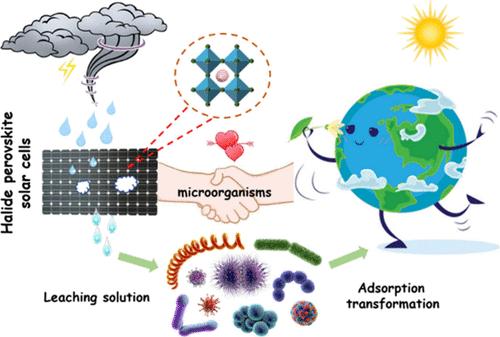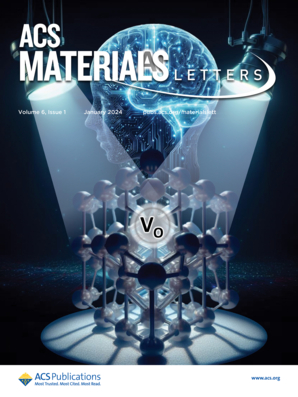利用微生物固定技术提高过氧化物光伏技术的环境可持续性
IF 9.6
1区 化学
Q1 MATERIALS SCIENCE, MULTIDISCIPLINARY
引用次数: 0
摘要
在新兴光伏技术中,金属卤化物过氧化物太阳能电池(PSCs)显示出越来越大的商业化潜力。然而,PSCs 中的重金属离子(如铅(II)和锡(II))的潜在泄漏对环境和健康构成了重大威胁,但环境的应对能力仍然未知。这项工作开创性地报告了环境在应对包晶石泄漏风险方面的自然修复潜力。我们发现,环境废弃物酵母能通过物理和化学吸附机制有效捕获泄漏的铅(II)和锡(II)。这些包晶重金属被进一步生物转化和固定。此外,我们的研究还显示,锡离子的去除率更高,这表明通过应用无铅包晶光伏技术,环境的可持续性得到了增强。这项研究提出了一种微生物净化策略,用于清除环境中的包晶重金属,为推动包晶光伏技术的实际应用做出了贡献。本文章由计算机程序翻译,如有差异,请以英文原文为准。

Microbial Immobilization for Enhancing Environmental Sustainability of Perovskite Photovoltaics
Metal halide perovskite solar cells (PSCs) demonstrate growing commercialization potential among emerging photovoltaic technologies. However, the potential leakage of heavy metal ions such as Pb(II) and Sn(II) from PSCs poses significant environmental and health threats, yet the environment’s capacity to respond remains unknown. This work pioneeringly reports the environment’s natural remediation potential in addressing the risks of perovskite leakage. We find that environmental waste yeasts can efficiently capture leaked Pb(II) and Sn(II) through a combination of physical and chemical adsorption mechanisms. These perovskite heavy metals are further biotransformed and immobilized. Additionally, our study shows a higher removal rate for Sn ions, revealing enhanced environmental sustainability by applying lead-free perovskite photovoltaics. This work conveys a microbial cleanup strategy for removing perovskite heavy metals from the environment, contributing to the advancing practical implementation of perovskite photovoltaics.
求助全文
通过发布文献求助,成功后即可免费获取论文全文。
去求助
来源期刊

ACS Materials Letters
MATERIALS SCIENCE, MULTIDISCIPLINARY-
CiteScore
14.60
自引率
3.50%
发文量
261
期刊介绍:
ACS Materials Letters is a journal that publishes high-quality and urgent papers at the forefront of fundamental and applied research in the field of materials science. It aims to bridge the gap between materials and other disciplines such as chemistry, engineering, and biology. The journal encourages multidisciplinary and innovative research that addresses global challenges. Papers submitted to ACS Materials Letters should clearly demonstrate the need for rapid disclosure of key results. The journal is interested in various areas including the design, synthesis, characterization, and evaluation of emerging materials, understanding the relationships between structure, property, and performance, as well as developing materials for applications in energy, environment, biomedical, electronics, and catalysis. The journal has a 2-year impact factor of 11.4 and is dedicated to publishing transformative materials research with fast processing times. The editors and staff of ACS Materials Letters actively participate in major scientific conferences and engage closely with readers and authors. The journal also maintains an active presence on social media to provide authors with greater visibility.
 求助内容:
求助内容: 应助结果提醒方式:
应助结果提醒方式:


